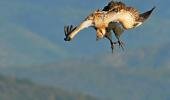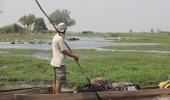Words: Alan Hobson ǀ Photos: Courtesy of Angler & Antelope
When anyone takes up a new hobby it is always a tough decision as to what equipment you should buy without blowing the budget, just in case you don’t get into the sport. With so much information and as many points of view on the internet, it is easy to become confused. So where do you begin?
Photo by: Angler & Antelope
Aspiring fishermen are usually apprehensive about signing up for lessons or a clinic in case they make a fool of themselves. Well, the good news is that in fly fishing, there is no such thing as a bad cast. As long as you get your fly in the water, you have a chance of catching a fish. Children hold very few inhibitions in experimenting with new things, a lesson adults should adopt because old dogs can be taught new tricks.
Fly fishing is all about science and nature, and the skills of casting with a fly rod are complicated when we add ourselves to the equation. The principles of transferring energy by using a flimsy fly rod to cast a fly, mostly made of fur and feathers that weigh very little, is easy to understand. However, when you are standing with the rod in your hand and there's a vast expanse of water in front of you and bush behind you, your hand-eye coordination somehow disconnects. The thought that a fly, which looks like a 'little gogga', when presented onto the water and twitched can fool a fish, sounds like a plot for an alien movie.
Equipment
Visions of goggas and aliens aside, the art of fly fishing is simple, really. To enjoy this wonderful sport, all you need to get started is a fly rod, a reel spooled with backing (extra line), and some insect-looking things called flies that are connected by your tippet to the leader.
There are several entry-level combination sets (consists of rod, reel with backing, line and leader, and a few flies) available, which are no more expensive than a premium brand of sneakers or jeans. Although fly fishing also boasts a range of very desirable brands, countries in the East produce very functional equipment at good prices. When deciding what combination set is right for you and fits your budget, my best advice would be to visit a fly fishing speciality shop and ask the salesman to supply you with a starter kit based on your specific needs. To give you some idea of what you are in for, you can pick up an entry-level kit from as little as R500. But your money, roughly R1 500, would be better spent on equipment good enough to last several years.
Rods
The equipment used to fly fish is scientifically based. For example, rods are generally made from carbon fibre, the same material used to build the cockpits of aeroplanes, which is very strong and flexible. An all-purpose rod would be a #5 weight rod. This describes the rating of the rod to be able to cast a specific weight of fly line. Rods are weighted from 000 weight, being extremely light, up to 14 weight, being very heavy and strong. The lighter the rod, the smaller the fly you can present and the lighter the tippet to be used, with a diameter the same thickness as your hair.
Leader and tippet
The leader and tippet are a strong, durable, transparent material between the end of the fly line and your fly, usually monofilament, and essential for catching fish. They allow for a smooth, invisible presentation of your fly, yet are strong enough to bring in that large fish you have been trying to catch. Using the correct leader and tippet is just as important as using the correct fly.
Rod weight
The weight of a rod also has a bearing on the strength of the rod, as it determines the size and weight of fly you can cast. The lighter the rod, the less pressure you can exert on the fish, which means you will usually use a light rod to catch smaller fish. The heavier the rod, the bigger the fish one targets using a thicker diameter line with a much greater breaking strain. For example, you would use a #12 to #14 weight rod to catch a sailfish. Therefore, a #5 weight rod will allow you to target most fresh-water species in our waters.
Reel
The reel usually matches the rating of the rod, and it determines the size and diameter of the reel. A reel is not simply a device to store line; it has a drag, and a breaking system that allows you to put pressure on a fish to stop it from swimming away when fighting it. Normally, we have some backing, called Dacron, on the reel for the odd occasion your catch-of-a-life-time tears off into the deep.
Fly line
Your fly line also has a specific rating, usually matching the weight of the rod, so that the rod is capable of casting that weight of line. You can use either a floating, intermediate, or sinking line. The fly line is made of Dacron, which is coated with plastic and either impregnated with air bubbles to make it float or tiny chips of tungsten to make it sink. The amount/weight of tungsten chips determines how fast the line sinks. Usually, an intermediate line will sink at a rate of 1-2 inches per second, and the sinking line up to 7 inches per second. Whilst fishing, it is always a good idea to count your line down to determine at what level the fish are feeding.
Coaching
When starting out, it is advisable to engage the services of a professional to teach you the correct way to cast, as old habits are always the most difficult to change. Having said that, it is more important just to give it a try. The satisfaction of being able to present your fly where you intended it to go, fooling the fish in its own environment, feeling the adrenalin rush of the fight, and having the privilege of releasing the fish for someone else to catch is indescribably rewarding.
Photo by: Angler & Antelope
Accessories
In addition to the equipment mentioned above, there are a few other items you should think about purchasing to make your fishing experience more enjoyable.
Sunglasses
Sunglasses provide UV protection for your eyes, but just as importantly, they will stop that fly from hooking in your eye. When choosing a pair of sunglasses, ensure they are polarised because this will reduce the sun's glare off the water.
Net
A net not only makes landing your fish easier but when used correctly, it is actually better for the fish as well, as you can keep the fish in the water when removing your fly, thus reducing the stress on the fish.
Fly box
Store and organise all your flies in a fly box. There are various styles to choose from that offer either individual compartments to hold several flies or they come with a soft styrofoam-type material that you can hook your flies on. The choice is yours.
Hat
Don't leave home without a good quality, wide brimmed hat. When it's hot, it will protect you from those killer rays and when it is cold, it will help keep the head and ears a bit warmer. A hat can also keep that errant fly from snagging your head.
Equipment and services Visit www.completeflyfisherman.co.za or www.africanangler.com, two world-class local fly fishing magazines that feature most of the speciality stores countrywide, as well as a range of specialist and services available. These magazines are available online or at a variety of outlets that sell magazines.
With these tips, you are now ready to take your fly fishing experience to a new and exhilarating level.











